Agenda Product and technology assessment Life

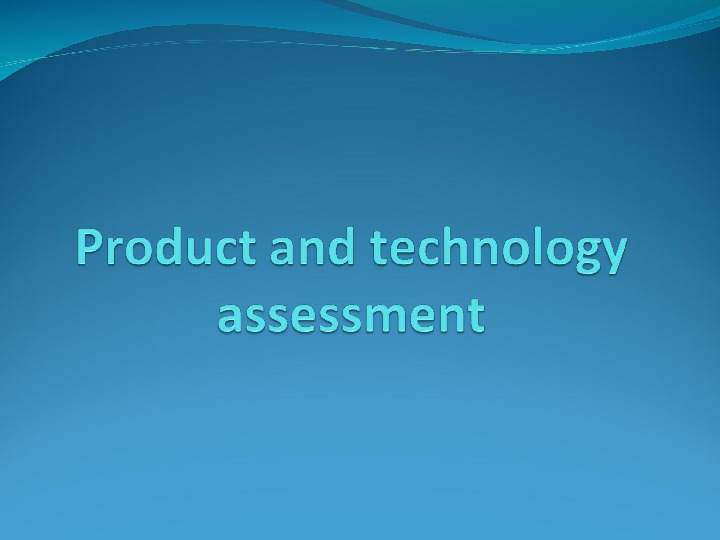





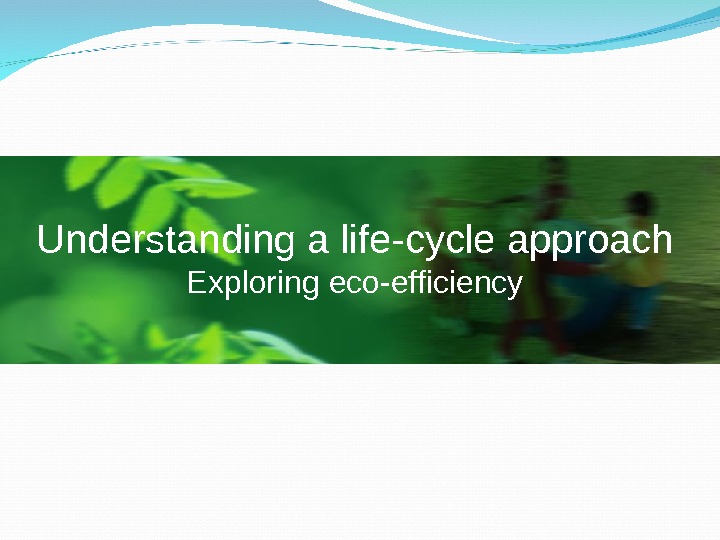



















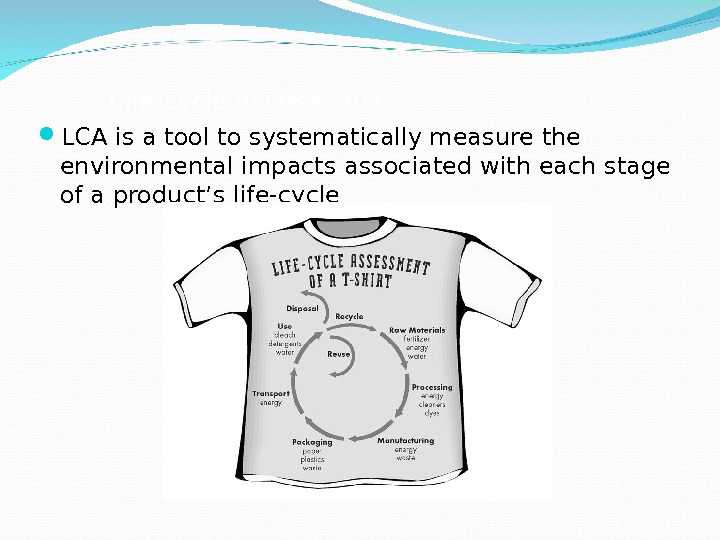













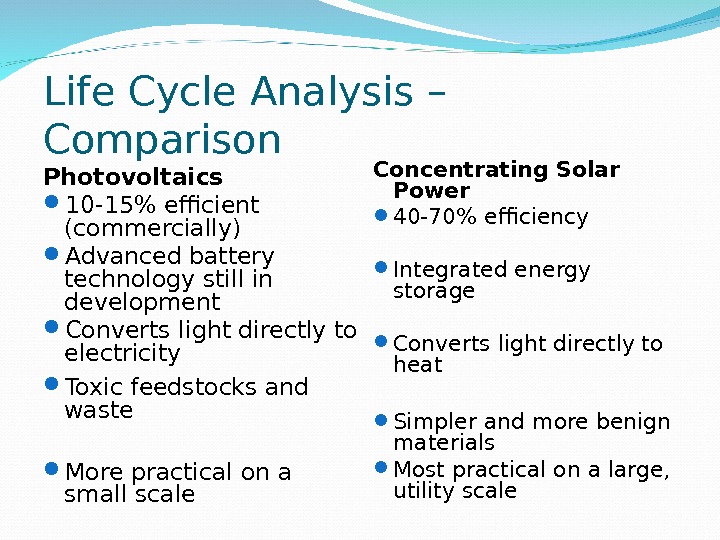
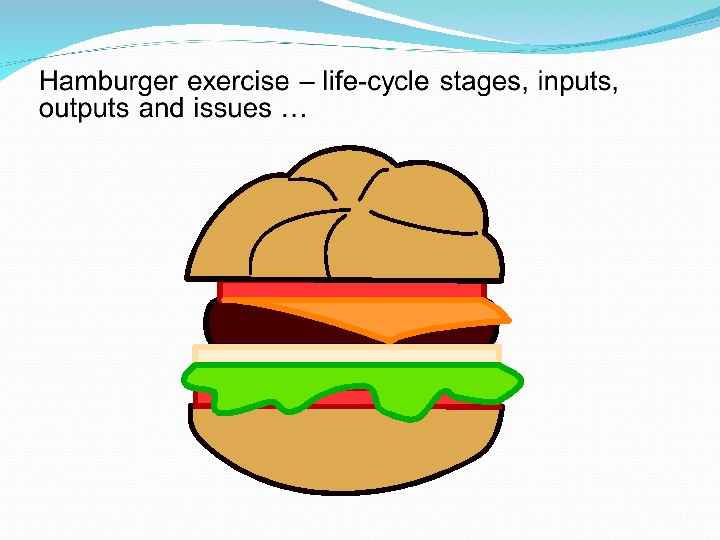
lecture_10_life_cycle_analyses.ppt
- Размер: 3 Mегабайта
- Количество слайдов: 42
Описание презентации Agenda Product and technology assessment Life по слайдам

 Agenda Product and technology assessment Life Cycle Assessment
Agenda Product and technology assessment Life Cycle Assessment
 Product and technology assessment (PATA) It is a systematic assessment of primary, secondary, and tertiary impacts of products and technologies with respect to: Health Safety Environment & Society That covers the life cycle from raw materials to final disposal.
Product and technology assessment (PATA) It is a systematic assessment of primary, secondary, and tertiary impacts of products and technologies with respect to: Health Safety Environment & Society That covers the life cycle from raw materials to final disposal.
 PATA is used for: Designing regulations and guidelines; Approving new products & technologies; Designing & improving products; Making purchasing decisions.
PATA is used for: Designing regulations and guidelines; Approving new products & technologies; Designing & improving products; Making purchasing decisions.
 Sources and perspectives of PATA Science, engineering, technology Economics and finance Political, cultural and social sources Ideological & political thought Religious organisations. PATA is a process that relies on a set of different assessment approaches, in particular, Life Cycle Assessment (LCA). PATA differs from LCA by including health, safety, social and cultural factors and by not having an established methodology. Other tools in the set include: Risk Management, Environmental Impact Assessment, Human Factors, and Environmental Communications.
Sources and perspectives of PATA Science, engineering, technology Economics and finance Political, cultural and social sources Ideological & political thought Religious organisations. PATA is a process that relies on a set of different assessment approaches, in particular, Life Cycle Assessment (LCA). PATA differs from LCA by including health, safety, social and cultural factors and by not having an established methodology. Other tools in the set include: Risk Management, Environmental Impact Assessment, Human Factors, and Environmental Communications.
 Life Cycle Assessment (LCA) An LCA is an assessment of the environmental effects a product or service has during its lifetime, from cradle to grave. In an LCA all the important processes during the products lifecycle is included. An LCA can for example be used for assessing how much greenhouse gas is emitted to the environment during the production of one litre milk.
Life Cycle Assessment (LCA) An LCA is an assessment of the environmental effects a product or service has during its lifetime, from cradle to grave. In an LCA all the important processes during the products lifecycle is included. An LCA can for example be used for assessing how much greenhouse gas is emitted to the environment during the production of one litre milk.
 Understanding a life-cycle approach Exploring eco-efficiency
Understanding a life-cycle approach Exploring eco-efficiency
 Did you know… Producing one ton of recycled steel saves the energy equivalent of 3. 6 barrels of oil and 1. 5 tons of iron ore, compared to the production of new steel? Producing paper using a chlorine-free process uses between 20 and 25 percent less water than conventional chlorine-based paper production processes?
Did you know… Producing one ton of recycled steel saves the energy equivalent of 3. 6 barrels of oil and 1. 5 tons of iron ore, compared to the production of new steel? Producing paper using a chlorine-free process uses between 20 and 25 percent less water than conventional chlorine-based paper production processes?
 Learning objectives Recognize where products come from and where they go after use = life-cycle Think about a product’s impacts on the environment and economy throughout Qualify impacts Quantify impacts
Learning objectives Recognize where products come from and where they go after use = life-cycle Think about a product’s impacts on the environment and economy throughout Qualify impacts Quantify impacts
 Choosing boundaries and shifting issues A life-cycle approach Life-cycle assessment – one tool. Life-cycle – what is it? Segue to life-cycle exercise. Structure
Choosing boundaries and shifting issues A life-cycle approach Life-cycle assessment – one tool. Life-cycle – what is it? Segue to life-cycle exercise. Structure
 Phases in a Life Cycle Assessment
Phases in a Life Cycle Assessment
 Worldwatch Institute, Worldwatch Paper 166: Purchasing Power: Harnessing Institutional Procurement for People and the Planet, July 2003, www. worldwatch. org
Worldwatch Institute, Worldwatch Paper 166: Purchasing Power: Harnessing Institutional Procurement for People and the Planet, July 2003, www. worldwatch. org
 Life-cycle stages Products can be evaluated through each stage of their life-cycle: Extraction or acquisition of raw materials Manufacturing and processing Distribution and transportation Use and reuse Recycling Disposal For each stage, identify inputs of materials and energy received; outputs of useful product and waste emissions Find optimal points for improvement – eco-efficiency
Life-cycle stages Products can be evaluated through each stage of their life-cycle: Extraction or acquisition of raw materials Manufacturing and processing Distribution and transportation Use and reuse Recycling Disposal For each stage, identify inputs of materials and energy received; outputs of useful product and waste emissions Find optimal points for improvement – eco-efficiency
 A life-cycle approach Ensures companies identify the multiple environmental and resource issues across the entire life-cycle of the product Knowledge of these issues informs business activities: planning, procurement, design, marketing & sales Rather than just looking at the amount of waste that ends up in a landfill or an incinerator, a life-cycle approach identifies energy use, material inputs and waste generated from the time raw materials are obtained to the final disposal of the product * * Product Life-Cycle Analysis: Environmental activities for the classroom, Waste Management and Research Center, Champaign, IL,
A life-cycle approach Ensures companies identify the multiple environmental and resource issues across the entire life-cycle of the product Knowledge of these issues informs business activities: planning, procurement, design, marketing & sales Rather than just looking at the amount of waste that ends up in a landfill or an incinerator, a life-cycle approach identifies energy use, material inputs and waste generated from the time raw materials are obtained to the final disposal of the product * * Product Life-Cycle Analysis: Environmental activities for the classroom, Waste Management and Research Center, Champaign, IL,
 Estimated amount of synthetic fertilizers and pesticides it takes to produce the cotton for a conventional pair of jeans. Source: “The Organic Cotton Site: Ten good reasons”
Estimated amount of synthetic fertilizers and pesticides it takes to produce the cotton for a conventional pair of jeans. Source: “The Organic Cotton Site: Ten good reasons”

 Worldwatch Institute, Worldwatch Paper 166: Purchasing Power: Harnessing Institutional Procurement for People and the Planet, July 2003, www. worldwatch. org Pesticides Finishing chemicals
Worldwatch Institute, Worldwatch Paper 166: Purchasing Power: Harnessing Institutional Procurement for People and the Planet, July 2003, www. worldwatch. org Pesticides Finishing chemicals
 Life-cycle – identify the boundaries
Life-cycle – identify the boundaries
 Life cycle of print products
Life cycle of print products
 Life-cycle – helps avoid shifting the issues Looking at the entire life-cycle helps ensure reducing waste at one point does not simply create more waste at another point in the life-cycle Issues may be shifted – intentionally or inadvertently – among: Processes or manufacturing sites Geographic location Different budgets and planning cycles (first cost) Environmental media – air, water, soil Sustainability dimension: economic, social, environmental burdens Depends on “boundaries” Be conscious of what is shifted and to where!
Life-cycle – helps avoid shifting the issues Looking at the entire life-cycle helps ensure reducing waste at one point does not simply create more waste at another point in the life-cycle Issues may be shifted – intentionally or inadvertently – among: Processes or manufacturing sites Geographic location Different budgets and planning cycles (first cost) Environmental media – air, water, soil Sustainability dimension: economic, social, environmental burdens Depends on “boundaries” Be conscious of what is shifted and to where!


 US Geological Survey, http: //www. nwrc. usgs. gov/world/content/water 1. html
US Geological Survey, http: //www. nwrc. usgs. gov/world/content/water 1. html

 Life-cycle – identify issues and costs Purchase Price Refrigerator A appears cheaper Price + Life-Cycle Costs Refrigerator B costs less overall Refrigerator A Refrigerator B$ $ Disposal & Post-Dispos al Use Acquisition
Life-cycle – identify issues and costs Purchase Price Refrigerator A appears cheaper Price + Life-Cycle Costs Refrigerator B costs less overall Refrigerator A Refrigerator B$ $ Disposal & Post-Dispos al Use Acquisition
 A life-cycle approach With a life-cycle approach, companies employ the tools they need to: Reduce impacts across the life-cycle Capitalize on opportunities for their business Tools range from simple mapping of life-cycle stages to comprehensive quantitative assessments
A life-cycle approach With a life-cycle approach, companies employ the tools they need to: Reduce impacts across the life-cycle Capitalize on opportunities for their business Tools range from simple mapping of life-cycle stages to comprehensive quantitative assessments
 Life-cycle assessment LCA is a tool to systematically measure the environmental impacts associated with each stage of a product’s life-cycle
Life-cycle assessment LCA is a tool to systematically measure the environmental impacts associated with each stage of a product’s life-cycle
 Assessment of relative impacts across life-cycle – 3 issues are included
Assessment of relative impacts across life-cycle – 3 issues are included
 Life-cycle assessment Two attributes make LCA distinct and useful as an analytical tool: whole system consideration of the total product life-cycle presentation of tradeoffs among multiple environmental issues LCA is quantitative
Life-cycle assessment Two attributes make LCA distinct and useful as an analytical tool: whole system consideration of the total product life-cycle presentation of tradeoffs among multiple environmental issues LCA is quantitative
 How to do LCA 1. Determine scope and system boundaries functional unit life-cycle stages define “unit processes” 2. Data collection 3. Analysis of inputs and outputs 4. Assessment of numerous environmental issues 5. Interpretation LCA principles and framework are standardized by the Organization for International Standardization’s 14040 series of standards (ISO 14040)
How to do LCA 1. Determine scope and system boundaries functional unit life-cycle stages define “unit processes” 2. Data collection 3. Analysis of inputs and outputs 4. Assessment of numerous environmental issues 5. Interpretation LCA principles and framework are standardized by the Organization for International Standardization’s 14040 series of standards (ISO 14040)
 Conclusions – why take a life-cycle approach? Systems perspective Integrates environment into core business issues Efficiency Innovation Better return on investment – identify point of “biggest bang for the buck” * Engage stakeholders – investors, customers, employees Environment is not a cost center for the company, but a business opportunity * www. ciwmb. ca. gov/EPP/Life. Cycle/default. htm
Conclusions – why take a life-cycle approach? Systems perspective Integrates environment into core business issues Efficiency Innovation Better return on investment – identify point of “biggest bang for the buck” * Engage stakeholders – investors, customers, employees Environment is not a cost center for the company, but a business opportunity * www. ciwmb. ca. gov/EPP/Life. Cycle/default. htm
 Conclusions – why take a life-cycle approach? Systems perspective Integrates environment into core business issues Efficiency Innovation Better return on investment Engage stakeholders Environment is not a cost center for the company, but a business opportunity Look beyond the company’s gate Expose trade-offs and opportunities Expand analysis of products, projects, policies and programs – what is the function, what are the boundaries, what are the impacts, where are the opportunities?
Conclusions – why take a life-cycle approach? Systems perspective Integrates environment into core business issues Efficiency Innovation Better return on investment Engage stakeholders Environment is not a cost center for the company, but a business opportunity Look beyond the company’s gate Expose trade-offs and opportunities Expand analysis of products, projects, policies and programs – what is the function, what are the boundaries, what are the impacts, where are the opportunities?
 Purpose of LCAs A company can use LCAs for several purposes: To give the company an overview of the environmental impacts internally, which gives the company foundation for making environmental improvements and thereby decreasing their environmental impacts. To put pressure on the company’s suppliers to make more environmentally friendly raw materials. In marketing, where the company can market one or more of their products on its environmental profile or they can market their products compared to other similar products on the market. In product development phase, eco-design. In eco-design an LCA can be used for assessing the possible environmental impacts from a product that is under development. The LCA results can this way be used to change parameters in the product or the production here of.
Purpose of LCAs A company can use LCAs for several purposes: To give the company an overview of the environmental impacts internally, which gives the company foundation for making environmental improvements and thereby decreasing their environmental impacts. To put pressure on the company’s suppliers to make more environmentally friendly raw materials. In marketing, where the company can market one or more of their products on its environmental profile or they can market their products compared to other similar products on the market. In product development phase, eco-design. In eco-design an LCA can be used for assessing the possible environmental impacts from a product that is under development. The LCA results can this way be used to change parameters in the product or the production here of.
 Source: Sandia National Laboratories
Source: Sandia National Laboratories
 Background – Photovoltaics (PV) Converts light directly to electricity Created in 1950 s for satellite use — Vanguard I, 1958 • Use on land began in 1970 s Most widely known and adopted solar technology today Source: Total. com
Background – Photovoltaics (PV) Converts light directly to electricity Created in 1950 s for satellite use — Vanguard I, 1958 • Use on land began in 1970 s Most widely known and adopted solar technology today Source: Total. com
 Life Cycle Analysis (LCA) Traditional evaluations only consider the “use” phase of life More accurate and comprehensive analyses consider a product «from cradle to grave” Each phase of life factors into the LCA: Raw Material Acquisition Manufacturing Transport Use/Maintenance Recycle/Waste Management
Life Cycle Analysis (LCA) Traditional evaluations only consider the “use” phase of life More accurate and comprehensive analyses consider a product «from cradle to grave” Each phase of life factors into the LCA: Raw Material Acquisition Manufacturing Transport Use/Maintenance Recycle/Waste Management
 Life Cycle Analysis Source: Lawrence Berkeley National Laboratory
Life Cycle Analysis Source: Lawrence Berkeley National Laboratory
 R = f ( H x E ) Risk, R Hazard, H Exposure, E Major hazards in PV manufacturing Requires the use of rare-earth metals, of which China controls 95% of the market Production undergoing rapid outsourcing to developing countries No well-established PV recycling program Module Types of Potential Hazards Crystalline-silicon (x-Si) HF acid burns Si. H 4 fires/explosions Pb solder/module disposal Amorphous-silicon (α-Si) Si. H 4 fires/explosions Cadmium Telluride (Cd. Te) Cd toxicity, carcinogenicity Module disposal Copper Indium Diselenide (CIS) Copper Indium Gallium Diselenide (CGS) H 2 Se toxicity Module disposal Gallium Arsenide (Ga. As) As. H 3 toxicity As carcinogenicity H 2 flammability Module disposal. Life Cycle Analysis – Photovoltaics Source: Brookhaven National Laboratory
R = f ( H x E ) Risk, R Hazard, H Exposure, E Major hazards in PV manufacturing Requires the use of rare-earth metals, of which China controls 95% of the market Production undergoing rapid outsourcing to developing countries No well-established PV recycling program Module Types of Potential Hazards Crystalline-silicon (x-Si) HF acid burns Si. H 4 fires/explosions Pb solder/module disposal Amorphous-silicon (α-Si) Si. H 4 fires/explosions Cadmium Telluride (Cd. Te) Cd toxicity, carcinogenicity Module disposal Copper Indium Diselenide (CIS) Copper Indium Gallium Diselenide (CGS) H 2 Se toxicity Module disposal Gallium Arsenide (Ga. As) As. H 3 toxicity As carcinogenicity H 2 flammability Module disposal. Life Cycle Analysis – Photovoltaics Source: Brookhaven National Laboratory
 Life Cycle Analysis – Concentrating Solar Power (CSP) Composed mainly of common metals, glass, concrete, and HTF Thermal hazard Requires higher intensity solar radiation than PV Allows for integrated energy storage Source: Sandia National Laboratory
Life Cycle Analysis – Concentrating Solar Power (CSP) Composed mainly of common metals, glass, concrete, and HTF Thermal hazard Requires higher intensity solar radiation than PV Allows for integrated energy storage Source: Sandia National Laboratory
 Life Cycle Analysis – CSP Source: National Renewable Energy Laboratory. Thermal energy storage allows for decoupling of energy collection and electricity generation
Life Cycle Analysis – CSP Source: National Renewable Energy Laboratory. Thermal energy storage allows for decoupling of energy collection and electricity generation
 Photovoltaics 10 -15% efficient (commercially) Advanced battery technology still in development Converts light directly to electricity Toxic feedstocks and waste More practical on a small scale Concentrating Solar Power 40 -70% efficiency Integrated energy storage Converts light directly to heat Simpler and more benign materials Most practical on a large, utility scale. Life Cycle Analysis – Comparison
Photovoltaics 10 -15% efficient (commercially) Advanced battery technology still in development Converts light directly to electricity Toxic feedstocks and waste More practical on a small scale Concentrating Solar Power 40 -70% efficiency Integrated energy storage Converts light directly to heat Simpler and more benign materials Most practical on a large, utility scale. Life Cycle Analysis – Comparison


